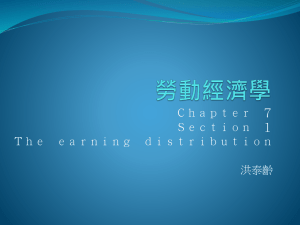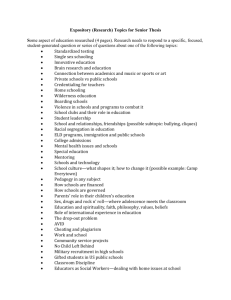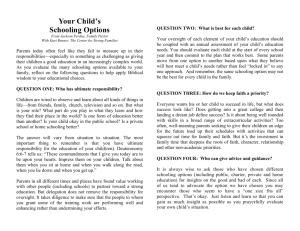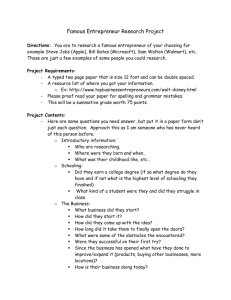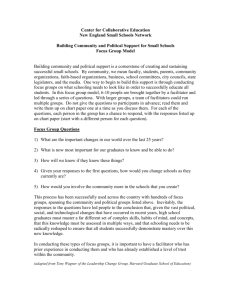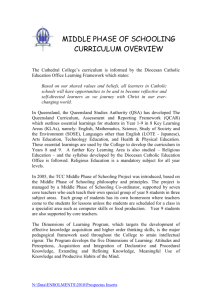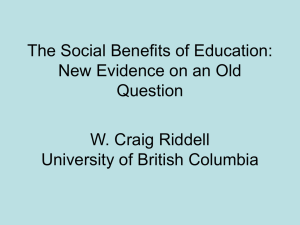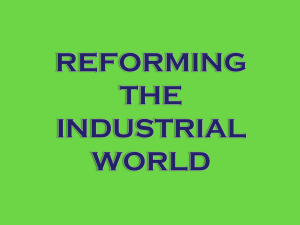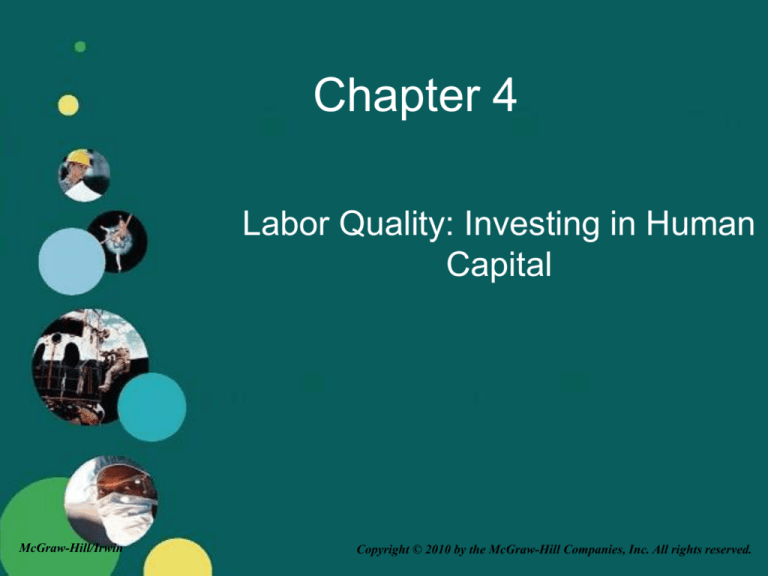
Chapter 4
Labor Quality: Investing in Human
Capital
McGraw-Hill/Irwin
Copyright © 2010 by the McGraw-Hill Companies, Inc. All rights reserved.
1. Investment in
Human Capital:
Concept and Data
Human Capital includes any activity
that increases worker quality and
productivity, i.e., education, training,
health & migration.
4-2
Investment in Human
Capital
o Expenditures on education and training can be
treated as an investment in human capital just
like investments in physical capital.
• Human capital yields a rate of return (higher
earnings) like physical capital.
o Educational attainment has been rising in the
U.S.
• In 1970, 36% of the labor force was a high school
dropout. In 2008, it was 12%. In 1970, 14% had 4+
years of college, in 2006 29%.
4-3
Age-Earnings Profiles,
by Education
• The male ageearnings profiles
indicate those
with more
education have
higher earnings.
• The ageearnings profiles
are steeper for
those with more
education.
• Females have
flatter ageearnings
profiles.
4-4
2. Human Capital
Model
4-5
Human Capital Model
o The decision should be made by comparing
the costs and benefits (higher earnings) of
college.
o Costs of attending college
• The direct costs are the cost of tuition, fees, and
books.
∞Room and board are not included since they are
needed regardless of whether you go to college.
• The indirect cost is the forgone earnings you
give up while you attending college.
4-6
Age-Earnings With and
Without College
• The HH curve is the ageearnings profile if a person does Annual Earnings
not attend college.
• The CC curve is the costearnings profile if one attends
college.
C
• The total cost of attending
college is the sum of the direct
costs (area 1) plus indirect
costs (area 2).
• The benefit of attending
college is the increase in
earnings due to the college
degree (area 3).
• Whether it is rational to attend
college depends on whether the
present value of the benefits
exceeds the present value of
the costs.
Incremental
Earnings (3)
H
H Indirect
Costs (2)
18
65
22
Age
C
Direct Costs (1)
4-7
Present Value
o Discounting converts the value
of future dollars into today’s
dollars through the interest rate.
The present value (Vp) of a payment
received one year from now is:
Def:
Vp
=
Payment 1 year from now
1+Interest rate
where i = 10%
Ex:
Vp
= $ 110 = $ 100.00
1.10
4-8
Present Value
The present value of a future
stream of incremental earnings or
costs (E) :
Vp
=
E0
E1
E2
En
.
.
.
.
.
+
+
+
+
(1 + i)
(1 + i)2
(1 + i)n
Costs are represented as negative
values of E.
A person should attend college if
the net present value (Vp) is greater
than 0.
4-9
Discounted Present Value
PV of $8,000 Investment in Webmaster Training Program
(Interest Rate = 10 Percent)
Year
(1)
0
1
2
3
Incremental
Earnings
(2)
-$ 8,000
$ 3,000
$ 4,000
$ 5,000
Discounted Value
(10 Percent Rate)
(3)
1.000
0.909
0.826
0.751
Present Value
of Earnings
(4)
$
$
$
$
-8,000
2,727
3,305
3,755
$ 1,787
• Suppose Melinda is considering taking a webmaster training
program that involves direct costs of $3,000 and forgone earnings
$5,000. The training program will increase Melinda’s earnings by
$3,000, $4,000, and $5,000 for the 3 years she plans on working.
• Because she can borrow the funds at an interest rate of 10%, we
will discount the future expected income at an 10% rate.
• What is the present value (PV) of this training program?
• The PV of the training program is positive, Melinda should take the
training program.
4-10
Internal Rate of Return
The internal rate of return, r, is the
rate of return at which Vp = 0:
E1
E2
En
.
.
.
.
.
+
Vp = 0 = E0 + (1 + r) + (1 + r)2 +
(1 + r)n
A person should attend college if
the rate of return (r) exceeds the
market interest rate (i).
4-11
Generalizations
o Length of income stream
• The longer the stream of positive incremental
earnings, the more likely the net present value
will be positive.
∞As a result, younger people are more likely to attend
college
o Costs of attending college
• The lower the cost of attending college, the
more likely the net present value is positive.
∞Older people have a higher opportunity cost of
attending college, less likely to attend.
4-12
Generalizations
o Earnings differential
• The larger the college-high school earnings
differential is, the more likely the net present
value is greater.
∞College attendance rose in the 1980s as the
college-high school premium increased.
o The Discount Rate (or market interest rate)
• The larger the Discount Rate (interest rate),
the smaller present value of future earnings,
so higher interest rates decrease college
attendance
4-13
Rate of Return by Country
• The rate of
return per year
of college
education varies
substantially
across countries
for males.
4-14
College-High School Wage
Premium
• The collegehigh school wage
premium fell in
the 1970s for
both men and
women.
• The premium
fell because of
an increase in
supply of college
graduates due to
the baby boom.
• The premium
rose after 1979,
due to increases
in the demand for
college-trained
workers because
of technology
improvements.
4-15
Caveats
o We can’t predict the college-high school
wage premium for future graduates.
• The charts report past differentials.
• The future differential may be smaller as the
high differential may increase future supply.
o These are average earnings of college and
high school graduates; the distribution of
earnings around the mean is wide.
o The quality of schooling matters as well as
the quantity of schooling.
4-16
Private vs. Social
Perspective
o Education yields substantial external or
social benefits that society reaps.
• More educated workers have lower
unemployment rates.
• Education raises the amount and quality of
participation in the political process.
• Children grow up in a better home environment
if the parents are more educated.
• The research discoveries of more educated
persons yield benefits to society.
4-17
Private vs. Social
Perspective
o The social rate of return is higher (lower)
than the private rate of return, resources will
be underallocated (overallocated) to human
capital investments.
• The private and social rate of return are quite
similar.
• Social return for human capital investments is
comparable to that for physical capital,
indicating that US does not over invest in formal
schooling.
4-18
Questions for Thought
1. Suppose the net present value of an educational
investment is highly positive. What can you infer
about the investment’s internal rate of return
relative to interest cost of borrowing?
2. Comment on the following statements:
(a) Older workers are less geographically mobile than
younger workers.
(b) An economic recession tends to stimulate college
enrollments.
(c) The age-earnings profiles shown earlier, clearly
indicate that people with more education earn more
than people with less education; therefore, personal
spending on education is always a good investment.
4-19
3. Human Capital Investment
and the Distribution of
Earnings
The willingness to invest in formal schooling
o determines future earnings
o determines the earnings distribution
o depends not only on expected time in the
labor market but also on ability,
discrimination and access to financing
4-20
• The marginal rate of return to
education declines as additional
schooling is acquired.
• Investment in education is
subject to the law of
diminishing returns. The
increases in knowledge
decline with each additional
year of schooling.
• The return also falls because
the explicit cost and
opportunity cost of education
rises with additional schooling.
Rate of Return
The Returns to Formal
Schooling
r
Years of Schooling
4-21
• Since individuals should
increase schooling so that the
marginal rate of return of
schooling (r) is equal to the
interest rate (i).
• Using the r = i rule, at
interest rate i2, the optimal
level of schooling is e2.
• At i1 the optimal level is e1.
• At i3 the optimal level is e3.
r, i
Demand for Human Capital
1
i
S1
1
2
i2
S2
3
i
S3
r, DHC
3
• Each equilibrium point (1,2,3)
indicates the “price” and
quantity demanded of human
capital. In other words, the
demand for human capital.
e1
e2
e3
Years of
Schooling
4-22
Returns to School will differ
because of:
o Innate ability differences between
individuals (High vs. Low)
o Discrimination differences
o Access to and cost of funds differences
o If the returns differ, then investment levels
will differ generating income differences
4-23
• Alfonse is low-ability person.
He has low mental/physical
talents and/or low motivation
and self-discipline. His demand
for schooling is DA.
• Bob is a high-ability person.
He has a greater demand for
schooling at DB because he
can better translate schooling
into higher productivity and
earnings.
• For a given interest rate, Bob
will obtain more schooling
which will compound the
earnings differential between
low and high ability persons.
r, i
Ability Differences
A
B
i
S
DB
DA
eA
eB
Years of
Schooling
4-24
• Albert is black and is
discriminated against in the
labor market. His demand for
schooling is DA since he has
low ability to convert additional
schooling into higher earnings.
• Brett is white and has a
greater demand for schooling
at DB as he can reap the
benefits of additional
schooling.
• For a given interest rate,
Brett will obtain more schooling
which will compound the
earnings differential between
whites and blacks.
r, i
Discrimination
A
B
i
S
DB
DA
eA
eB
Years of
Schooling
4-25
• Ann is from a wealthy family
and faces a low cost of
borrowing funds (iA). Her
optimal level of schooling is eA.
r, i
Access and Cost of Funds
B
iB
• Betty is from a poor family
and faces a high cost of
borrowing funds (iB). Her
optimal level of schooling is eB.
SB
A
iA
SA
DA= DB
eB
eA
Years of
Schooling
4-26
Interactions
o The ability, discrimination, and cost of
funds factors that affect schooling levels
may interact to cause even larger earnings
inequality.
• If a person faces labor market discrimination,
lenders may charge a higher interest rate
since they are less certain of getting repaid.
∞Discrimination will reduce both the supply and
demand for schooling.
∞Anti-discrimination policies may reduce earnings
inequality as a result.
∞Income inequality also reduces supply & demand 4-27
Capital Market Imperfections
o The capital market is biased in favor of
physical rather than human capital.
• Lenders can’t repossess human capital.
• Young people, who are most likely to invest in
human capital, don’t have established credit
ratings.
• Individual returns differ making lending risky
o Private markets are unlikely to equalize
physical and human capital returns leading
to underinvestment in human capital.
4-28
o Government subsidized loans can
equalize physical and human capital
returns and also provide access to
schooling for those unable to save (i.e.,
the poor).
o Without aid to the poor, some high ability
persons would not acquire enough
schooling and poverty would be
perpetuated.
4-29
Question for Thought
1. Describe the expected effects that college
scholarships based on (a) student ability and (b)
student need are likely to have on the distribution
of earnings.
4-30
4. On-the-Job Training
o Like formal schooling, OJT entails both
opportunity costs and future benefits which
can be analyzed thru the net present value
framework.
o If NPV (expected extra revenues – costs of
training) are > 0, firm will provide training.
4-31
Costs and Benefits
o Firms will invest in on-the-job training if the
present value of the benefits of the training
exceeds the present value of the costs.
o The costs to the firm include:
• Direct costs such as classroom instruction and
greater worker supervision.
• Indirect costs such as reduced worker output
during training.
o The benefit is greater worker productivity.
4-32
General and Specific
Training
o General training is training that is usable
at all firms and industries.
• Word processing skills or accounting skills
o Specific training is training that is usable
at only at the firm that provides the
training.
• Assembly procedure unique to a firm’s
product
o Most training is a mixture of general and
specific training.
4-33
• Wu and MRPu are the wages
and marginal revenue product
for an untrained worker.
Marginal revenue product is the
increase in total revenue
associated with the
employment of an additional
worker.
• Since general training is
usable at other firms, workers
must pay for the entire cost of
the training. They receive a
lower wage (Wu> Wt) that is
equal to their diminished
productivity (MRPt).
• After the training period,
workers receive a higher wage
Wp that is equal to their new
higher level of productivity
MRPp.
Wage & Marginal Revenue Product
General Training
Wp= MRPp
Wu= MRPu
Wt= MRPt
Training
Post Training
4-34
• Since specific training is not
transferable to other firms, the
employer must pay for the
training.
• During training, the employer
pays a wage greater than the
worker’s productivity (Wu>
MRPt).
• After training, the employer
gets a return on her training
investment by paying a wage
less than the worker’s
productivity (Wu < MRPt).
• The employer may pay a
higher wage to decrease
worker turnover and thus
protect her training investment
(Wp’ ).
Wage & Marginal Revenue Product
Specific Training
MRPp
W p’
Wu= MRPu
MRPt
Training
Post Training
4-35
Modifications
o Faced with a minimum wage, some firms
may pay for general training.
• The firms recoup their expenses by paying
workers less than their MRP after the training is
completed.
∞This is possible because workers are not perfectly
mobile across jobs—there are costs to switching jobs.
o Workers with the most formal education also
receive more on-the-job training.
• They have shown they can receive training
more readily and thus less cost.
4-36
Modifications
o Men will receive more OJT than women
because they’re expected to work more
years (no child raising years)
o Firms and workers who receive specific
training both want life-time jobs to recover
investments and to maximize wages.
Firms and workers who receive general
training will have less interest in limiting
job insecurity.
4-37
OJT Empirical Evidence
o College educated do receive more OJT
than those w/o
o Workers in large firms are more likely to
participate in OJT than small firms
o Most training is general not specific
o General training increases productivity but
specific training does not
4-38
Empirical Evidence (cont.)
o Each year of OJT with current employer
increases young worker’s wage 13%
o Firms offering OJT attract higher ability
workers
o More formal training increases
employment stability
o OJT differences play only a small role in
the gender wage gap
4-39
Question for Thought
1. Suppose that after graduation you take a job with
an employer that offers to pay full tuition for
employees wishing to return to school to get an
MBA degree during non-work hours. You are not
required to continue working for the firm after
getting your MBA. What type of training is this,
and who you think actually pays for it?
4-40
5. Criticisms of Human
Capital Theory
Benefits of formal schooling could be
mismeasured
• Education as Consumption
• Non-wage benefits
• Ability Differences
• Screening Hypothesis
4-41
Investment or Consumption?
o Not all education expenditures are an
investment because some part is a
consumption expenditure.
• Courses such as music appreciation yield
consumption benefits rather than investment
benefits.
• By ignoring the consumption benefits of
education, researchers overstate the
investment costs of education and understate
the rate of return.
4-42
Non-Wage Benefits
o Studies that only examine the earnings
of high school and college graduates
understate the rate of return for two
reasons.
1. College graduates have greater fringe
benefits as a percent of pay than high
school graduates.
2. College graduates tend to work in more
pleasant surroundings and have more
interesting jobs than high school graduates.
4-43
Ability Problem
o Those with more ability (i.e., intelligence,
motivation, and self-discipline) are more
likely to go to college.
• Even without a college degree, they would have
earned more than those who decided not to go
to college.
• To the extent that the higher earnings of college
graduates reflects their greater ability rather than
schooling, the rate of return is overstated.
∞Omission of ability biases the rate of return estimates
by a small amount.
4-44
Screening Hypothesis
o The screening hypothesis argues that
schooling increases earnings not by
increasing productivity but by providing a
way to identify high-quality workers.
• Screening does not affect the private rate of
return, since college graduates still have
higher earnings.
∞The social rate of return is overstated, as screening
does not increase productivity, so public investment
in education is too high.
• The empirical evidence is mixed
4-45

